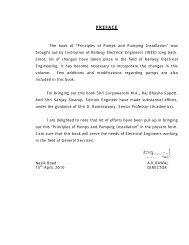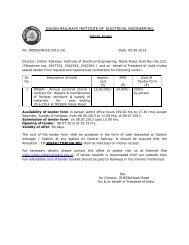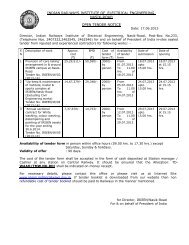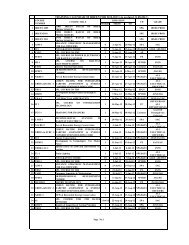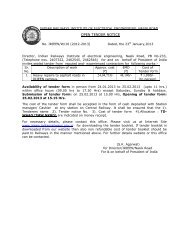Cover - Train Lighting - Indian Railways Institute of Electrical ...
Cover - Train Lighting - Indian Railways Institute of Electrical ...
Cover - Train Lighting - Indian Railways Institute of Electrical ...
You also want an ePaper? Increase the reach of your titles
YUMPU automatically turns print PDFs into web optimized ePapers that Google loves.
4. BATTERIES<br />
4.0 Conventional Lead Acid Cells for TL applications are governed by IS 6848.<br />
4.1 Type <strong>of</strong> cells in use for train lighting and coach air-conditioning are as under :-<br />
Capacity <strong>of</strong> battery in AH<br />
at 27 Degree C at 10 Hr Rate<br />
Type <strong>of</strong> coach<br />
where generally used<br />
120 110 V, BG coaches<br />
450 MG AC Coach<br />
525 Jan Shatabdi Non - AC coaches<br />
800 II AC BG Coaches (Old) (Under-slung type)<br />
1100 II AC BG Coaches (new)/AC 3 Tier Coach<br />
4.2 Principle <strong>of</strong> Operation :<br />
In a charged lead acid cell positive active material consists <strong>of</strong> lead peroxide (PbO2)<br />
and the negative <strong>of</strong> spongy lead (Pb). Dilute sulphuric acid (H2SO4 + H2O) serves as<br />
electrolyte.<br />
The overall reactions inside the cell during discharge and charge are represented<br />
most -conveniently by a reversible equation as follows :-<br />
PbO2 + Pb + 2H2SO4 2PbSO4 + 2H2O<br />
During discharge, the lead peroxide on the positive plates as well as the spongy lead<br />
on the negative plates are converted into lead sulphate (PbSO4). In this process, sulphuric<br />
acid (H2SO4) is consumed and water (H2O) is formed. Consequently, the specific gravity <strong>of</strong><br />
the electrolyte falls, the extent <strong>of</strong> fall being proportional to the ampere-hours taken out. The<br />
process causes at first a slow, and then a faster voltage drop, until a permissible lower limit<br />
(final discharge voltage) is reached, which depends on the rate <strong>of</strong> discharge current. The<br />
amount <strong>of</strong> ampere-hours (constant current x time) taken out is called the capacity <strong>of</strong> the cell<br />
at this rate.<br />
The chemical process during charge is the reverse <strong>of</strong> that during discharge. The<br />
lead-sulphate on the positive plates is reconverted into lead peroxide and the lead sulphate in<br />
the negative plates into spongy lead. Sulphuric acid is formed and the water consumed. The<br />
specific gravity <strong>of</strong> the electrolyte rises. There is at first a slow, later a faster rise <strong>of</strong> cell<br />
voltage. From 2.4 volts onwards gassing sets in due to a strong decomposition <strong>of</strong> water into<br />
hydrogen and oxygen. Violent gassing is injurious to the plate material. So after reaching this<br />
gassing voltage the rate <strong>of</strong> the charging current must be limited to within safe permissible<br />
values.<br />
GENERAL SERVICES : TRAIN LIGHTING 43






